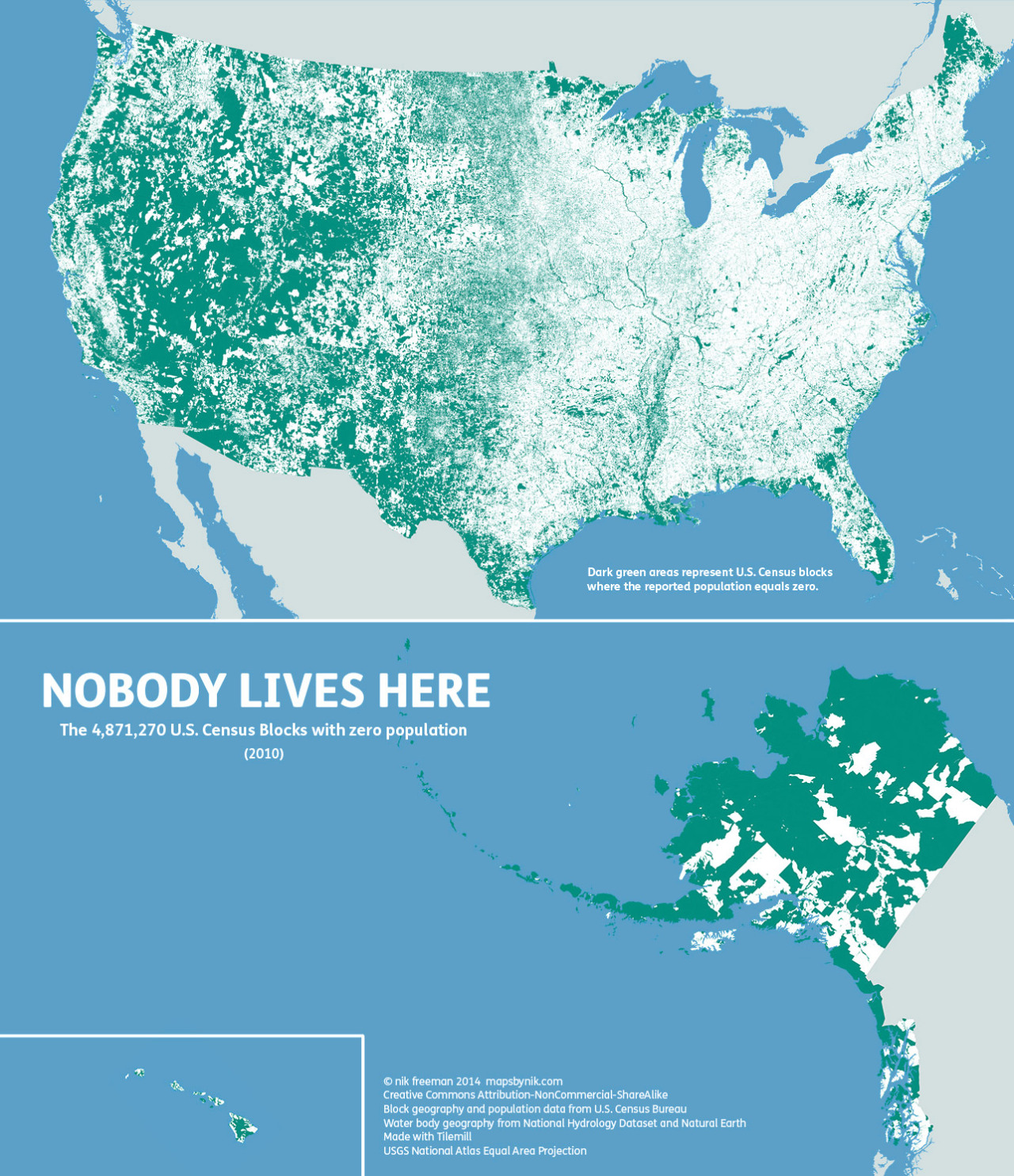Nobody lives here: The nearly 5 million Census Blocks with zero population A Block is the smallest a
Nobody lives here: The nearly 5 million Census Blocks with zero population A Block is the smallest area unit used by the U.S. Census Bureau for tabulating statistics. As of the 2010 census, the United States consists of 11,078,300 Census Blocks. Of them, 4,871,270 blocks totaling 4.61 million square kilometers were reported to have no population living inside them. Despite having a population of more than 310 million people, 47 percent of the USA remains unoccupied. Green shading indicates unoccupied Census Blocks. A single inhabitant is enough to omit a block from shading. Update Jan 2015: Prints and canvas of the Nobody Live Here map are now available. Update 2014.05.01: I’ve received a couple questions about Canada. Just to be clear, this map is of the United States only. It is based on 2010 data published by the U.S. Census Bureau, which for reasons I hope are apparent, does not include data on our friends in the Great White North. For a similar depiction of Canada, see this map whipped up by Michael Chung. Map observations The map tends to highlight two types of areas: places where human habitation is physically restrictive or impossible, and places where human habitation is prohibited by social or legal convention. Water features such lakes, rivers, swamps and floodplains are revealed as places where it is hard for people to live. In addition, the mountains and deserts of the West, with their hostility to human survival, remain largely void of permanent population. Of the places where settlement is prohibited, the most apparent are wilderness protection and recreational areas (such as national and state parks) and military bases. At the national and regional scales, these places appear as large green tracts surrounded by otherwise populated countryside. At the local level, city and county parks emerge in contrast to their developed urban and suburban surroundings. At this scale, even major roads such as highways and interstates stretch like ribbons across the landscape. Commercial and industrial areas are also likely to be green on this map. The local shopping mall, an office park, a warehouse district or a factory may have their own Census Blocks. But if people don’t live there, they will be considered “uninhabited”. So it should be noted that just because a block is unoccupied, that does not mean it is undeveloped. Perhaps the two most notable anomalies on the map occur in Maine and the Dakotas. Northern Maine is conspicuously uninhabited. Despite being one of the earliest regions in North America to be settled by Europeans, the population there remains so low that large portions of the state’s interior have yet to be politically organized. In the Dakotas, the border between North and South appears to be unexpectedly stark. Geographic phenomena typically do not respect artificial human boundaries. Throughout the rest of the map, state lines are often difficult to distinguish. But in the Dakotas, northern South Dakota is quite distinct from southern North Dakota. This is especially surprising considering that the county-level population density on both sides of the border is about the same at less than 10 people per square mile. Update: On a more detailed examination of those two states, I’m convinced the contrast here is due to differences in the sizes of the blocks. North Dakota’s blocks are more consistently small (StDev of 3.3) while South Dakota’s are more varied in area (StDev of 9.28). West of the Missouri River, South Dakota’s blocks are substantially larger than those in ND, so a single inhabitant can appear to take up more space. Between the states, this provides a good lesson in how changing the size and shape of a geographic unit can alter perceptions of the landscape. Finally, the differences between the eastern and western halves of the contiguous 48 states are particularly stark to me. In the east, with its larger population, unpopulated places are more likely to stand out on the map. In the west, the opposite is true. There, population centers stand out against the wilderness. :: Ultimately, I made this map to show a different side of the United States. Human geographers spend so much time thinking about where people are. I thought I might bring some new insight by showing where they are not, adding contrast and context to the typical displays of the country’s population geography. I’ve all but scratched the surface of insight available from examining this map. There’s a lot of data here. What trends and patterns do you see? Errata Due to a cartographic mishap, the Gulf of California was missing from the original version. Though it was quickly fixed, that version keeps popping up across the Internet. It displeases me I see it, yet I’m amused that people keep reposting it without noticing the error. The geography gods judge those people harshly. Some islands may be missing on the hi-res edition if they were not a part of the waterbody data sets I used. :: ©mapsbynik 2014 Creative Commons Attribution-NonCommercial-ShareAlike Block geography and population data from U.S. Census Bureau Water body geography from National Hydrology Dataset and Natural Earth Made with Tilemill USGS National Atlas Equal Area Projection -- source link
Tumblr Blog : tumblr.mapsbynik.com
#unitedstates#population#census#geography#visualization
